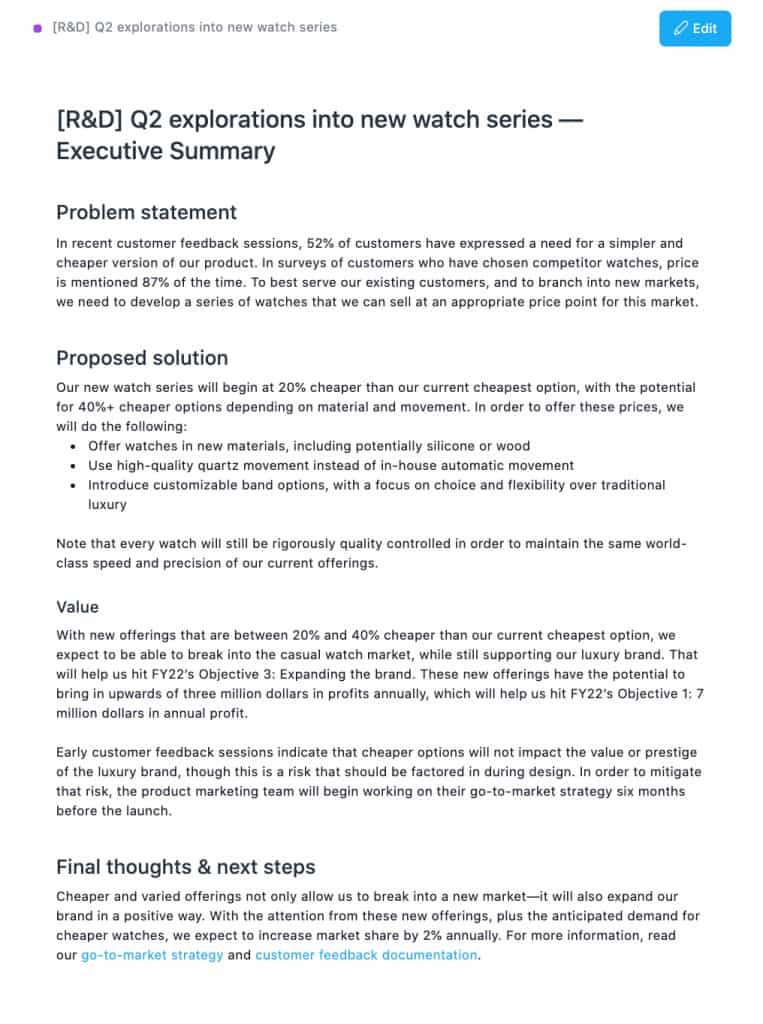A business report is an official document that conveys crucial information to the concerned stakeholders. Therefore it needs to be prepared following a correct structure to serve its purpose. In this guide, we have listed 8 essential elements of a business report along with the dos and don’ts of report writing.
Structure of report in business communication
The structure of a business report can be divided into three parts, The Front Matter, The Body of the Report, and The Back Matter.
(A)-Front Matter
1) Letter of transmittal (Cover letter)
2) Title page
3) Executive summary
4) Table of content
5) List of figures/ Illustration
(B)-Body of the report
6) Introduction
7) Findings and Documentation
8) Conclusion and Recommendation
(C)-Back Matter
9) Appendices, References, and Glossary
Note: The letter of transmittal is an optional element of reporting which may or may not be included depending on the type of report prepared.
8 Essential elements of business report writing
(A)Front Matter
The Front Matter of a business report serves as an introduction to the document, providing essential information and helping readers navigate the report with ease. It sets the context for the main body of the report, which contains the in-depth analysis, findings, and conclusions.
1/ Title Page:
The title page is the cover page of the business report. It is one of the essential elements of a business report as It includes the main information about the report and its presentation. The typical elements found on a title page include:
- Report Title: A clear and descriptive title that represents the main topic or purpose of the report.
- Author’s Name: Refers to the individual or team responsible for composing the report.
- Date of Submission: The date when the report is submitted or published.
- Organization or Department: The name of the company, organization, or department to which the report is addressed.
- Other Details: Depending on the specific requirements or guidelines, the title page may include additional information, such as the report’s reference number, the name of the intended recipient, or contact information.

2/ Table of Contents:
The table of contents provides a structured outline of the business report’s contents, including all the major sections and subsections and their corresponding page numbers. It helps readers navigate the report efficiently, making it easy to find specific information or sections of interest. The table of contents typically includes:
- Main Sections: The main sections of the report, such as Introduction, Findings, Analysis, Conclusions, and Recommendations, are listed in the table of contents.
- Subsections: If the report is divided into subsections, such as different aspects of the analysis or multiple case studies, these should also be listed in the table of contents.
- Page Numbers: Each entry in the table of contents is followed by the page number where that specific section or subsection can be found in the report.
3/ Executive Summary:
The executive summary is a concise and focused overview of the entire business report. It serves as a snapshot of the report’s main points and is typically written after the main report is completed. Key features of the executive summary include:
- Brevity: The executive summary is usually limited to one or two pages, providing a brief yet comprehensive summary of the report.
- Key Findings: It highlights the most critical findings, conclusions, and recommendations of the report.
- Purpose: The executive summary explains the purpose of the report and the problem it aims to address.
- Target Audience: The summary is often written for busy executives or stakeholders who need a quick understanding of the report without delving into the full details.

Note: You can further check out the following blog by Hubpots on powerfull executive summary for more details.
4/ List of Figures and Tables (if applicable):
If the business report contains multiple figures (such as charts, graphs, and diagrams) and tables, a list is provided to identify and locate these visual elements within the report. Key points about the list of figures and tables include:
- Identification: Each figure and table in the report is assigned a number and a clear, descriptive caption.
- Page Numbers: The list of figures and tables includes the page numbers where each figure and table appear in the report.
- Necessity: The list of figures and tables is especially helpful when the report contains a substantial amount of visual information, making it easier for readers to find and reference specific graphics.

(B)Body of a Report
The “Body of the Report” is the core element of the business report, containing substantial information, analysis, and insights that inform decision-making and problem-solving. The conclusions and recommendations are crucial sections that provide valuable guidance for stakeholders and readers.
5/ Introduction:
The introduction establishes the context for the entire business report. It provides background information about the topic, outlines the purpose and objectives of the report, and establishes the context for the reader. Key elements of the introduction include:
- Background: An explanation of the problem, issue, or subject matter being addressed in the report, along with any relevant historical or contextual information.
- Purpose: A clear statement of the report’s goals and objectives, highlighting what the report aims to achieve or what questions it seeks to answer.
- Scope: An indication of the boundaries and limitations of the report, defining what aspects will be covered and what will be excluded.
- Methodology (if not included as a separate section): Briefly mention the research methods or approach used to gather data and conduct the analysis.
Extra Reading:
Depending on the type of report the findings section can be presented separately within the contents of the business report or it can be discussed as part of the analysis section.
The findings section presents the raw data, facts, or information gathered during the research or investigation. It is a neutral and objective presentation of the data without any analysis or interpretation. Key aspects of the findings section include:
- Clarity: The findings are presented with clarity and in a well-organized manner, often using tables, charts, graphs, or bullet points to enhance readability.
- Relevance: Only data directly related to the research objectives should be included in this section.
- Labels and Captions: Figures and tables should be appropriately labeled and captioned to help readers understand the data’s significance.
6/ Analysis and Discussion:
In this section, the data presented in the findings are interpreted and analyzed to draw meaningful conclusions. The analysis provides insights into the data, identifies patterns or trends, and addresses the research objectives. Key points to consider in the analysis and discussion section are:
- Interpretation: A thorough explanation of the significance of the findings and how they relate to the research question or problem.
- Comparison: If applicable, the analysis may compare the data with relevant benchmarks, previous studies, or industry standards.
- Supporting Evidence: The analysis should be supported by evidence from the findings, referring back to the raw data presented earlier.
- Limitations: Recognizing and discussing any limitations or potential sources of bias that might impact the validity of the analysis.
7/ Conclusions and Recommendations:
The conclusions section provides a summary of the key points derived from the analysis. It answers the research question or addresses the problem stated in the introduction. Important aspects of the conclusions section include:
- Objectivity: Conclusions should be based solely on the evidence presented in the analysis, without introducing new information or personal opinions.
- Conciseness: Conclusions should be concise, highlighting the main outcomes and insights of the report.
- Link to Objectives: The conclusions should directly tie back to the report’s objectives and the research question.
The recommendations section suggests actionable proposals or solutions based on the conclusions drawn from the analysis. Recommendations should be specific, practical, and closely related to the report’s objectives. Key elements of the recommendations section include:
- Feasibility: Recommendations should be realistic and feasible within the context of the report’s findings and limitations.
- Justification: Each recommendation should be supported by the analysis and evidence presented earlier in the report.
- Implementation Plan: If appropriate, include a plan or outline for how the recommendations can be implemented, including potential challenges and benefits.
(C)Back Matter
The “Back Matter” section, comprising the appendices and references, enhances the credibility and completeness of the business report by providing supplementary materials and acknowledging the sources of information used.
8/ Appendices and References:
The appendices are the last component of a business report and act as supplementary materials that provide additional information to the report but are not included in the main body. The purpose of the appendices is to offer detailed information that supports the findings and analysis presented in the report. Key aspects of the appendices include:
- Supporting Data: Appendices may include raw data, detailed calculations, survey questionnaires, interview transcripts, or any other information that is too extensive or technical to include in the main report.
- Reference Materials: Supplementary documents, such as legal agreements, contracts, or technical specifications, can be included in the appendices to provide context or background information.
Appendices are not meant to be read sequentially like the main body of the report but are available for reference when readers seek more in-depth information.
The report’s references or bibliography section contains a comprehensive list of all the sources cited throughout the document. This section is essential for maintaining the report’s credibility and allowing readers to verify the information presented. Key components of the references or bibliography section include:
- Citations: All sources, such as books, research papers, articles, websites, or other materials referenced in the report, are listed alphabetically by the author’s last names.
- Full Information: Each entry includes the author’s name(s), publication title, publication date, publisher, and any other relevant details required by the citation style.
- How to Make a Business Report Reader-Friendly
- Common Mistakes To Avoid While Writing a Business Report
How to Make a Business Report Reader-Friendly
Business reports are documents used to communicate information. They should be written in a way that is easy for the reader to understand. The style, language, grammar, and structure need to be clear and concise.
Here are some ways to make a report ‘reader-friendly’:
Presentation
- Using a consistent font scheme that is easy to read
- Use of abbreviations and acronyms
- Using white space on a page generously
- Numbering the headings
Structure
- Short introduction and conclusion
- Single idea per paragraph
- Following an overall theme
- Writing a strong conclusion
- Easy-to-read format
Language
- Clear and simple language
- Grammatically correct and consistent
- Using synonyms for commonly repeating words
- Avoiding emotional and personal language
Common Mistakes To Avoid While Writing a Business Report
- Using first-person pronouns such as “I”, “Me”, etc.
- Ignoring the author’s guidelines for writing the report.
- Not following a consistent writing style and format.
- Making language complex and stretching out descriptions.
- Using passive voice more than active voice.
- Not proofreading the report carefully.
- Using unverified and inaccurate data.
- Using sexist and/or racist phrases.
- Using slang language and incorrect grammar.
- Not including footnotes where further information is required.
Frequently Asked Questions
Q1) What is business report and elements of business reports?
Ans: Business reports are formal documents that provide information and analysis on specific business activities, operations, or projects, aiming to present data and recommendations in a structured manner to support decision-making processes. The key elements of a business report typically include a title page, table of contents, executive summary, introduction, methodology (in research-based reports), findings/results, analysis, and discussion, recommendations, conclusion, and appendices for supplementary information.
Q2) What are the elements of the front matter of a business report?
Ans: The front matter of a business report includes key elements: the Title Page with essential details, an Executive Summary providing a concise overview, a Table of Contents for easy navigation, and a List of Figures and Tables (if applicable) for quick reference. These elements introduce the report, present crucial findings, and aid reader comprehension.
Q3) Which element is not part of a business report?
Ans: The element that is not typically part of a business report is an “Acknowledgment” section. Unlike some other types of formal documents, such as research papers, business reports usually do not include an acknowledgment section.
Q4) What are the three parts of a business report?
Ans: A business report consists of three main parts: the introduction, body, and conclusion with recommendations. These parts collectively form a comprehensive and valuable business report, supporting decision-making within the organization.
Q5) What are the types of business reports?
Ans: Business reports come in various types, including financial reports, annual reports, formal and informal business reports, feasibility reports, and informational reports. These reports serve specific purposes, providing crucial information for decision-making and achieving business objectives.
Q6) What is the importance of a business report?
Ans: Business reports are vital for organizations as they enable informed decision-making, performance evaluation, planning, and risk identification. Reports serve as valuable records and drive continuous improvement, fostering growth and competitiveness in the business landscape.
Q7) What are the characteristics of a business report?
Ans: Business reports have key characteristics that make them valuable tools for conveying information within organizations. They are formal, objective, and well-structured, following a logical sequence from front matter to end matter. Accuracy is crucial, and they present only relevant information concisely. Their purpose-driven approach ensures they serve specific objectives, and when applicable, they provide actionable recommendations. By reflecting these characteristics, business reports gain credibility and value in supporting informed decision-making processes.



